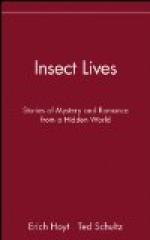On the other hand, the digestive system of insects that undergo a metamorphosis, passes through a profound crisis of dissolution and rebuilding. This is not surprising when we remember that there is often a great difference between larva and imago in the nature of the food. The digestive canal of a caterpillar runs a fairly straight course through the body and consists of a gullet, stomach (mid-gut), intestine, and rectum; it is adapted for the digestion of solid food. In the butterfly there is one outgrowth of the gullet in the head—a pharyngeal sac adapted for sucking liquids; and another outgrowth at the hinder end of the gullet (which is much longer than in the larva)—a crop or food-reservoir lying in the abdomen. The intestine of the butterfly also is longer than that of the larva, being coiled or twisted. Towards the end of the last larval stage, the cells of the inner coat (epithelium) lining the stomach begin to undergo degeneration, small replacing cells appearing between their bases and later giving rise to the more delicate epithelium that lines the mid-gut of the imago. The larval cells are shed into the cavity of the stomach and become completely broken down. J. Anglas (1902), describing these microscopic changes in the transformations of wasps and bees, has shown that the tiny replacing cells can be recognised in sections through the digestive canal of a very young larva; they may be regarded as representing imaginal buds of the adult gastric epithelium. In the transformations of two-winged flies of the bluebottle group, A. Kowalevsky (1887) has shown that these replacing cells are aggregated in little masses scattered at different points along the stomach and thus corresponding rather closely to the imaginal discs of the legs and wings.
The gullet, crop, and gizzard of an insect, which lie in front of the stomach, are lined by cells derived from the outer skin (ectoderm) which is pushed in to form what is called the ‘fore-gut.’ Similarly the intestine and rectum, behind the stomach, are lined with ectodermal cells which arise from the inpushed ‘hind-gut.’ The larval fore- and hind-guts are broken down at the end of larval life and their lining is replaced by fresh tissue derived from two imaginal bands which surround the cavity of the digestive tube, one at the hinder end of the fore-gut, and the other at the front end of the hind-gut. The larval salivary glands in connection with the gullet are also broken down, and fresh glands are formed for the imago.
A large part of the substance of an insect larva consists of muscular tissue, surrounding the digestive tube, and forming the great muscles that move the various parts of the body, and of fat, surrounding the organs and serving as a store of food-material. Very many of the muscle-fibres and the fat-cells also become disintegrated during the late larval and pupal stages, and the corresponding tissues of the adult are new formations derived from special groups of imaginal cells, though some muscles may persist from the larva to the adult. Similarly the complex air-tube or tracheal system of the larva is broken down and a fresh set of tubes is developed, adapted to the altered body-form of pupa and imago.




